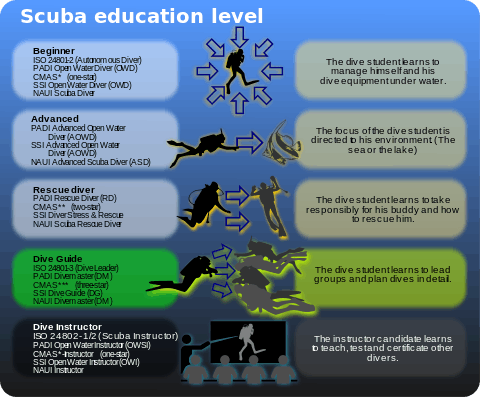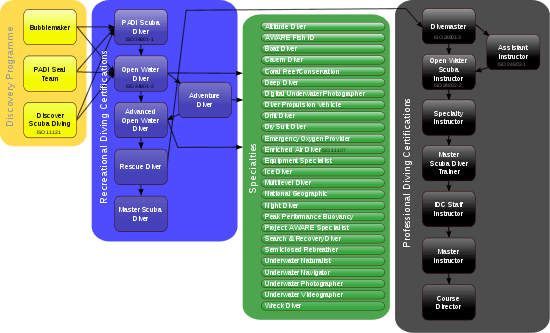Supervised diver
Supervised diver specifies the training and certification for recreational scuba divers in international standard ISO 24801-1 [1] and the equivalent European Standard EN 14153-1. Various diving organizations offer diving training that meets the requirements of the Supervised Diver. A diving certification which corresponds to the Supervised Diver allows for recreational diving under the direct supervision of a divemaster or recreational diving instructor in open water. Most diving organizations recommend not to exceed a diving depth of 10 to 12 metres . After the successful completion of a training equivalent to the Supervised diver, training can be extended to the Autonomous diver certification level (according to ISO 24801-2).

Before initial diver training and thereafter at regular intervals, a diver should undergo a fitness to dive examination by a diving doctor. In some countries, such an examination is required by law and is a prerequisite for any training in many diving schools.
In some parts of the world there is minimum requirement which corresponds to the Autonomous Diver certification and an in-date medical certificate for hiring diving equipment and taking part in recreational diving. In these places a certificate which only corresponds to the Supervised Diver is regarded as insufficient.
Scope of the standard
International standard ISO 24801-1 includes:[1]
- Prerequisites for training, including age and health requirements,
- Required theoretical knowledge regarding scuba and basic diving equipment, the basic physics of diving, medical problems related to diving, the diving environment, scuba diver separation procedure, and the use of nitrox breathing gases,
- Required scuba skills in confined and open water,
- Practical training parameters,
- Evaluation of knowledge and practical skills.
Training according to ISO 24801-1
Every year around 1.7 million people are trained according to ISO 24801.[2] Despite the standardization, the dive courses of individual diving organizations differ considerably in their content, expansion and philosophy. However, the minimum requirements defined in the ISO standard guarantee that a diver can easily convert between training organizations.
The following certifications meet the requirements for Supervised Diver:
CMAS
Confédération Mondiale des Activités Subaquatiques (CMAS) itself does not offer any training which corresponds to the Supervised Diver.[3] However, there are some CMAS affiliates (e.g. VDST or IAC ) that offer such training and certification independently of CMAS. It is usually called Basic Diver or similar. However, the content, regulations and designations of the individual CMAS member organizations can vary considerably.
NAUI Passport Diver
The NAUI Passport Diver (PD) is not a diving certification, it is only an entry level experience opportunity for interested amateurs to try out recreational diving. In this course, all the contents required by the standard for the Supervised Diver are taught.[4] The Passport Diver training includes two guided dives in limited open water, with a previous theoretical introduction. The Passport Diver experience does not include certification, but can be counted towards a NAUI Scuba Diver course (SD) within six months. The Passport Diver experience does not require prior experience of diving, but normal physical health and fitness are required. Persons who wish to participate in a Passport Diver offer must be at least 12 years old, but a NAUI Junior Passport Diver can be done at the age of eight.[5] The experience for children differs only by a child-oriented presentation of the same contents.
PADI Scuba Diver

PADI Scuba Diver (SD) is a basic diver training course where a diver can learn all the content required in the ISO standard for a Supervised Diver. PADI allows SD divers to dive to a depth of 12 meters, accompanied by a PADI Divemaster or Instructor .
The PADI Scuba Diver course includes the first three lessons of the five-part Open Water Diver course (OWD). Due to the modular design, Open Water Diver training can be divided into two courses, of which the first is PADI Scuba Diver. The SD course includes three theory and three swimming pool lessons, and at least two dives in open water with the scuba. PADI follows the "dive today" philosophy - after a theory lesson, dives usually take place on the same day. The pool dives - which can also take place in calm, current free, shallow open water, provide the training in the basic and emergency skills, including getting into the water, breathing under water using the regulator, use of fins, basic buoyancy control, mask clearing and regulator recovery.[6] The same exercises are partly repeated in the open water dives.
PADI-SD training can be started without prior experience of diving. Normal physical health and fitness are required. Persons who wish to attend an SD course must be at least 15 years old, but a PADI Junior SD course (JSD) can be attended at the age of 10 years. The children's dive course differs only in a child-oriented mediation of the same contents.
SSI Scuba Diver
The SSI Scuba Diver (SD) is a basic diver certification equivalent to the Supervised Diver standard. The training shall include at least two open water dives, which may only be carried out after the successful completion of the theoretical training. SSI allows SD divers, accompanied by a dive guide or instructor, to dive to a maximum depth of 12 meters.[7] After successful completion, training can be continued with Open Water Diver Training (OWD). The SSI SD course does not require previous experience of diving. Normal physical health and fitness are required and an SSI Medical Statement is issued. The learner must be able to swim 180 meters without an aid. Persons who wish to attend an SD course must be at least 15 years old, but SSI Junior SD training can be done at the age of 10 years.[7] The children's dive course differs only in a child-oriented mediation of the same contents.
Other training agencies
Some diving organizations dispense with a training level corresponding to the Supervised Diver and define the contents of the Autonomous Diver according to (ISO 24801-2) as the lowest level of training and breeding. In addition to the above, the following training corresponds to the Supervised Diver according to ISO 24801-1:[8]
| Diver certification agency | Training and certification | ||
|---|---|---|---|
| Disabled Divers International | DDI | Supervised Diver | SD |
| International Association for Handicapped Divers | IAHD | Tourist Diver | TD |
| International Scuba Diving Academy | ISDA | Scuba Diver | SD |
| National Academy of Scuba Educators | NASE | Scuba Diver | SD |
| National Diving League | NDL | Novice Diver | ND |
| Verband Deutscher Tauchlehrer | VDTL | Basic Diver | |
| Worldwide Academy of Scuba Educators | WASE | Scuba Diver | SD |
| World Organisation of Scuba Diving | WOSD | Supervised Diver | SD |
References
- "Recreational diving services — Requirements for the training of recreational scuba divers — Part 1: Level 1 — Supervised diver (ISO 24801-1)". ISO. Retrieved 2017-06-13.
- 945 000 annual certification by PADI "Worldwide Corporate Statistics 2013 - Data for 2007-2012" (PDF). PADI. February 2013. Archived from the original (PDF) on 2013-11-02. Retrieved 2013-11-01. with market share of 56%, Greg (2013-07-25). "2013 Market Share of Scuba Certification Agencies (PADI, NAUI, SSI)". DiveBuddy.com. Retrieved 2013-11-01. gives a total of about 1.7 million.
- "Training Map". CMAS International. Retrieved 2014-03-17.
- "Certificate" (PDF). Nr. EUF - CB 2007 004 (in German). European Underwater Federation (EUF). Retrieved 2013-12-02.
- Markus vom Scheidt. "Tauchkurs NAUI Passport Diver" (in German). meintauchplatz.de. Archived from the original on 2013-02-23. Retrieved 2014-03-17.
- "PADI Open Water Diver Theorie"., Wolfgang Exler
- "2014 Training & Dive Center Standards". Scuba Schools International / v102813. Concept Systems International GmbH. 2013-10-28. p. REC-8. Retrieved 2014-02-25.
- "EUF Certified Training Systems/Training Organisations". European Underwater Federation (EUF). Retrieved 2017-04-21.